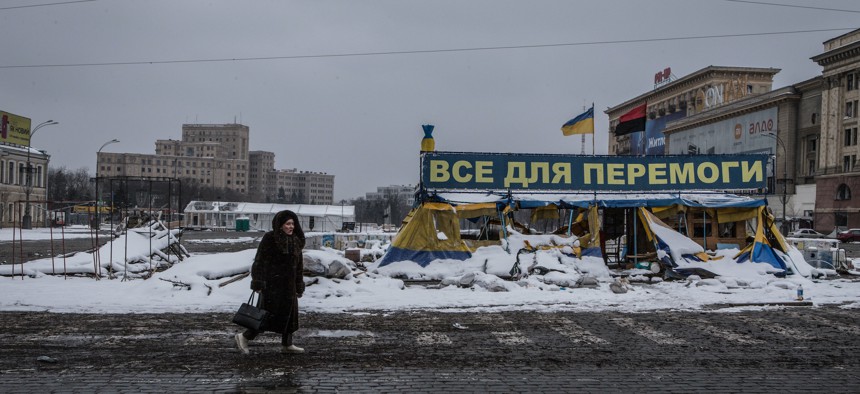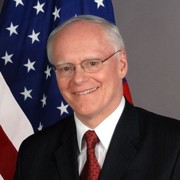
Effects of the bombing in the center of Kharkiv, Ukraine, on March 9, 2022 as Russian attacks continue. Anadolu Agency via Getty Images / Andrea Carrubba
President Biden’s State of the Union address, which called for the rest of the world to emerge stronger than Russia out of the Ukraine crisis, captures well an actual American strategy. The outcome of the crisis remains unknown, but the rules-based international collective security order, under American leadership, has done tolerably well in response so far. Still, the extraordinary economic and diplomatic isolation of Moscow, and beefing up of NATO’s eastern defenses, cannot guarantee that Russia will not eventually overrun Ukraine and create, with millions of Ukrainian refugees, an enormous financial crisis for the U.S. and European states. Ukrainians almost certainly will mount an insurgency, but while that will drive Moscow’s costs up, it is unlikely to force Russia to withdraw anytime soon.
Thus even a Russia weakened by international action and insurgency could still be the victor, if the international order emerges from this crisis even weaker geographically, economically, and psychologically. Job one for that international order thus is to ensure this does not happen, and that will require more action with greater risks and costs. One such action that has been raised, including by President Zelenskyy, is a no-fly zone over Ukrainian territory. This was quickly shot down for many good reasons. But the germ of the idea has merit, if it is approached differently. Here the conflict in Syria can be instructive, specifically, the efficacy of security zones, to deescalate conflict, enable humanitarian assistance, and eventually produce ceasefires.
A humanitarian safe zone
The Ukrainian government should be encouraged to appeal to the United Nations Security Council to pass a resolution under Chapter VI, establishing a Humanitarian Safe Zone with a ceasefire regime in Ukrainian territories abutting its Western neighbors. (A resolution under Chapter VII, which would allow legal enforcement with troops under U.N. control, would be better but undoubtedly impossible.) A model of this kind of peacekeeper border deployment is Resolution 1701, which ended the Israeli incursion into Lebanon in 2006.
Russia can be expected to veto such a resolution in the UN Security Council, upon which the administration and allies should attempt its passage in the General Assembly, as seen with the Uniting for Peace Resolution, which authorized the 1950 intervention in Korea. Last week, a similar General Assembly Resolution condemning Russia in Ukraine won an overwhelming majority.
Such a Zone would allow Ukrainian government and non-governmental organizations, partnered with the international community, to establish camps for internally displaced persons fleeing the fighting without leaving Ukraine, dramatically reducing costs of sustaining and resettling refugees in third countries. The location and depth of the Zone would depend on the location of Russian forces at the time it was instituted, as well as various economic, ethnic, transportation and geographic factors, and the position of countries neighboring the Zone. But it should include at least the strategic city of Lviv.
The Ukrainian government would have to renounce military operations launched from the zone, but otherwise Ukrainian sovereignty and normal government operations would continue in the Zone. A Zone would allow the Ukrainian government in extremis to relocate westward on its own territory rather than flee abroad. That is vital to any sort of compromise “win” for Ukraine as it would avoid, if in exile, competing with a Moscow puppet regime with an in-country presence. And to be clear, the end goal is not a rump Ukraine but the return of legitimate Ukrainian government control over all of the country.
A U.S. military role
What countries will answer the UN General Assembly’s call to send troops to monitor the Zone’s borders and defend it if attacked? (Given Russian fears, NATO as an institution must stay out of this.) Our experience with past conflicts indicates that governments will deploy forces only if the Security Council itself has passed a resolution (again, unlikely because of Russia’s veto), or if the United States sends its own troops. For this idea to succeed, then, the President would have to reverse, to a limited degree, his “no U.S. boots-in-Ukraine” position, but for good reasons.
The commitment would be limited, and would not directly challenge Russian forces. To reassure the Russians of no offensive intent, American and other outside forces would be limited in number and weapons. The U.S. could provide “over the horizon” air monitoring and ground reinforcements to deter or respond to attacks on these forces. No conflict would start except by a Russian decision to attack forces invited into Ukraine by its legal government and with a UN General Assembly mandate and humanitarian mission.
The Syrian experience
In Syria, Russia has not acted against security zones in the north or southeast containing Turkish or U.S. troops, even if few in number—with one exception, against Turkish forces in 2020. The Russians often threatened retaliation against U.S. and Turkish troops and their Syrian partners (and occasionally Israeli air strikes) but with that one exception took no lethal action.
One reason the security zone has worked in Syria was that each side knew the others’ red lines and did not have any compelling need to cross them. Russia had won a messy limited victory in Syria by propping up a friendly government and preserving its military bases. Pushing out for good the Americans, Turks, and Israelis, there for their own pressing security and humanitarian reasons, would have been welcome but would not generate enough additional benefit to balance the significant risks. Assuming the Ukraine security zone is relatively small, a similar dynamic could apply. No military offensive could or would be launched from it, thus it creates no compelling reason for Russia to risk initiating a conflict with the United States.
To be sure, a security zone will not end the war with a victory. Rather, it should be seen as one of a series of moves to deny Russia success, along with sanctions and economic decoupling and sending arms to Ukraine. It opens the door to a diplomatic compromise. The Biden administration signaled its openness to such an outcome in its January letter to Russia, and should follow up even while fighting continues.
Obviously, the security zone approach carries risks, both to the troops involved and to Russia-American escalation, particularly as the Ukraine conflict is existential to Russia in a way Syria was not. But the world, and the United States, is already in a very risky situation. Moreover, American success in creating a global coalition rests on the assumption that everyone will share in the sacrifice and risks. That includes not just those states pressed to sell more oil at less profit, or accept waves of refugees, or in Germany’s case, forgo Nordstream 2, but also the United States, which has so far been little exposed to costs and risks. At bottom, the Ukraine struggle is not about strength and resources, for the coalition that the U.S. has put together is massively stronger and richer than Russia. Rather, it is all about political courage and will.
James Jeffrey is chair of the Middle East program at the Wilson Center; a former U.S. ambassador to Turkey, Iraq, and Albania; and former Special Envoy to the Global Coalition To Defeat ISIS, and Syria chief of mission.
NEXT STORY: Establish a Zone of Peace in Western Ukraine




